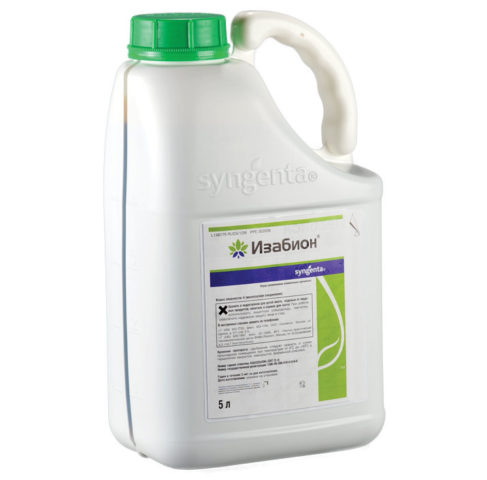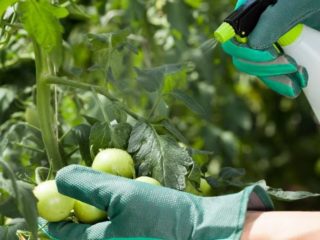Content
- 1 Description of the drug Izabion
- 2 Instructions for use of the drug Izabion
- 3 Combination with other drugs
- 4 Pros and cons of use
- 5 Conclusion
- 6 Reviews of Izabion fertilizer
Instructions for using Isabion fertilizer are clear even to beginners. The drug has a complex effect on most types of agricultural crops, improves the quantitative and qualitative characteristics of plants. The biological safety factor makes this type of feeding in demand and popular.
Description of the drug Izabion
The transition to organic farming is associated with many difficulties, including a drop in yields. Fertilizer "Isabion" is designed to level out these problems.
It is used for processing vegetable and fruit crops, flowers, trees and shrubs.The drug is classified as hazard class IV, the lowest for humans, pollinating bees and animals.
“Isabion” is an organic biostimulator of growth that provides plants with the amino acids and peptides they need.

"Isabion" is used as root and foliar feeding
The drug was developed in 2009 by the Swiss company Syngenta Crop Protection. The fertilizer showed excellent results in tests and was recommended for use during the transition from “chemical” farming to organic cultivation.
What color is Isabion
"Isabion" is a tea-colored or light brown liquid. The fertilizer is supplied in convenient plastic bottles of various sizes.
Composition of Isabion
The drug contains amino acids and peptides that have a significant effect on the growth of roots and green mass of plants. Their concentration is 62.5%.
The fertilizer also contains:
- nitrogen;
- organic carbohydrate;
- sodium;
- calcium;
- sulfates and chlorides.
The fertilizer is quickly absorbed and distributed along with the cell sap, stimulating the growth and development of agricultural plants.
Release forms of the drug Izabion
The product is available in the form of an aqueous solution with an acidity of 10% and a pH factor of 5.5-7.5 units. The form of sale of fertilizer is 1000 ml bottles, 10 ml portioned bags and 5 liter canisters.
Impact on soil and plants
Amino acid-peptide complexes, which are the basis of the drug, act as “transporters”, delivering protein molecules directly to the cells. As a result of intracellular processes, proteins and amino acids break down, releasing energy that stimulates the growth of the culture and increases its vitality.
Additionally, Isabion is capable of:
- Increase the rate of absorption and assimilation of nutrients by plants.
- Improve the stress resistance of plants after drought, prolonged starvation, disease or severe frost.
- Strengthen fertility.
- Reduce the number of barren flowers.
- Increase yields.
- Influence the chemical composition of fruits and berries (increase the content of sugar, organic acids).
- Affect the quality of the crop (presentation, color and size).
- Ensure simultaneous fruiting.
- Extend the shelf life of fruits and vegetables (keeping quality).
The pesticide "Isabion" is able to fight fungal spores, damaging the membranes at the molecular level and preventing the germs of the pathogen from germinating.

"Isabion" maintains and improves soil fertility
Methods of application
The methods of applying fertilizer are varied. It is used as a foliar and root fertilizer, mixed with water and used in the irrigation process. Judging by the reviews, the instructions for using Isabion provide comprehensive information about the methods and conditions for using the fertilizer.
In most cases, the drug is used in the process of spraying weakened plants. Fertilizing is carried out in the morning in calm weather at an air temperature of at least +15 ° C.
The drug is used as a root fertilizer in arid (dry) zones. Fertigation (watering with Isabion) is relevant in the case of picking seedlings, when planting fruit crops and grapes.
Consumption rates for Izabion
Application rates for Isabion fertilizer depend on many factors:
- soil type;
- environmental conditions;
- type of plant;
- method and purposes of application.
There are developmental phases during which the fertilizer demonstrates its greatest effectiveness. This factor is different for each culture. For some plants this is flowering, for others it is ripening, the formation of ovaries or a period of active growth of green mass.
Instructions for use of the drug Izabion
Methods of using Isabion on crops include root feeding, aerosol spraying and fertigation. In the instructions for the drug you can find not only application rates, but also the conditions under which crops should be fertilized.
How to breed correctly
Dilute the Isabion fertilizer in a working container immediately before use. ⅔ of the settled water (+19-22 °C) is poured into the container, then the calculated dose of the drug is administered, and if necessary, diluted with additional water.
After this, immediately begin aerosol spraying or watering. The fertilizer must be used within 24 hours after its preparation.
Rules of application
It is more advisable to spray in the morning, immediately after the dew has dried, or in the evening before condensation appears on the foliage. Despite the IV hazard class, all work with fertilizer must be carried out in special work clothes, gloves and a mask.
The shelf life of the drug does not exceed 3 years. Isabion fertilizer should be stored in places inaccessible to children and animals at a temperature not exceeding +25 °C.

The fertilizer can be stored even after opening the package for 3 years
For vegetable crops
Isabion is actively used as a biostimulant for vegetable crops. Most often, fertilizer is used in the form of foliar feeding by aerosol spraying.
Application of Isabion on tomatoes
Instructions for using Isabion for tomatoes allow for 5-7 treatments during the growing season. The first spraying is carried out at the time of picking seedlings, the next - before flowering. Then, at the moment of formation of the ovaries, the color of the fruit changes. Intermediate treatment is “prescribed” when there is a lack of lighting, low temperatures or during a dry period.
Application of Isabion on potatoes
Potatoes are processed 3 times a season. The first foliar spraying stimulates growth. It is carried out only after the shoots reach a height of 12-13 cm. The second treatment is planned at the beginning of flowering, and the third after 10-15 days. The purpose of the latter is to increase immunity to diseases.
Isabion for cucumbers
Foliar feeding of cucumber crops can also be carried out up to 5 times per season. In the instructions for using Isabion for spraying cucumbers, the dosage is 20 ml per 10 liters of water.

"Isabion" accelerates the absorption of nutrients by plants
For eggplants and peppers
Like tomatoes, eggplants and peppers can be processed up to 7 times (during the growing season). The first fertilization is carried out at the time of planting seedlings, then before flowering, setting and then depending on environmental conditions and the general condition of the crop.
For cabbage
As for cabbage, Isabion is used as root feeding. Fertilize the plant 4 times a season. The first time - at the time of picking seedlings to improve their survival rate, then - every 2 weeks.
For root vegetables
Root crops such as beets and carrots need to be fertilized 3 to 4 times a season. Spraying is carried out after the appearance of 4 leaves, then every 3 weeks. Approximate consumption is 100-120 ml per 10 liters of water.
For garlic and onions
To stimulate adaptability and strengthen the immune system, onion and garlic planting material is kept in Isabion (4%) for about 50-60 minutes. Then, during the season, fertigation is carried out (up to three times) at intervals of 20-21 days.
For melons and pumpkin crops
Pumpkin and melon plants are fertilized only by the root method. The first feeding is carried out after the appearance of the fourth leaf, the remaining leaves are based on the characteristics of the development of the crop. The interval between fertilizers is 10-14 days.

Pumpkin is fertilized through fertigation
For fruit and berry crops
Aerosol spraying is used for fruit and berry crops and shrubs. The consumption rate depends on the size of the plant, but on average it ranges from 1.5 to 2 liters per 10 m².
The first treatment is carried out at the time of budding, the second - during the formation of ovaries, the third - during the period of fruit filling, and the fourth - after harvesting until the foliage turns yellow.
A special item in the list of processed plants is grapes. The consumption of Isabion in this case ranges from 60 to 120 ml per 10 l, and the spraying area is similar to other fruit and berry crops.
The first treatment of grapes is carried out during the period of release of flower clusters, the second - at the beginning of the formation of fruits, the third - during the period of pouring berries (pea size), the last - at the moment of coloring of the fruits. If we are talking about light grape varieties, in which the color change is poorly visible - at the moment the skin is visible.

Isabion solution promotes the accumulation of sugars and organic acids in fruits
For garden flowers and ornamental shrubs
Spraying of shrubs and garden plants with Isabion is carried out in the spring when the buds awaken. Foliar feeding is also practiced when seedlings are picked, shoots reach 10 cm and 14-15 days after that. The number of treatments per season is no more than 3 times.
For indoor plants and flowers
Root watering with Isabion fertilizer for indoor plants can be carried out once a month. Approximate consumption is 20 ml per 10 liters of water. Aerosol spraying is also acceptable no more than once every 28-30 days. To do this, you will need 10 ml of the drug per 10 liters of water.
Combination with other drugs
Fertilizer "Isabion" demonstrates good compatibility with most micro- and macro-fertilizers, as well as pesticides. The product is incompatible with mineral oils and copper-containing preparations.
You can use Isabion after treatment, for example, with Bordeaux mixture, after 4 days. After spraying or watering with Isabion, copper-containing preparations can be used no earlier than 3 days later.
Pros and cons of use
The organic biostimulator "Isabion" has many advantages.
Its advantages include:
- Improving the quality characteristics of the soil, saturating it with oxygen.
- Destruction of harmful and pathogenic microorganisms in the soil.
- Increasing the degree of absorption of nutrients by plants.
- Compatible with most fertilizers and pesticides.
- Improving the adaptability of seedlings and seedlings.
- Increasing the immunity and stress resistance of young plants.
- Stimulation of growth, expansion of green mass, strengthening of shoots.
- Increased fertility.
- Improved yield indicators.
As a disadvantage, they indicate incompatibility with copper-containing preparations, as well as the sodium chloride ballast and nitrogen compounds included in the composition, the excess of which provokes increased growth of greenery and a decrease in yield.
Conclusion
The instructions for using the Isabion fertilizer clearly and clearly describe not only the dosage, but also the timing of fertilizing. Even a novice gardener or gardener can cope with the use of this type of fertilizer on a personal plot.
Reviews of Izabion fertilizer
Reviews from gardeners about Izabion are mostly positive. The main complaint is the high cost.








